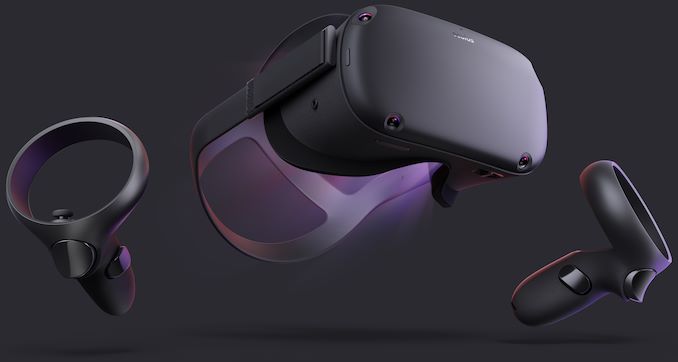Oculus Link Software: Connecting Oculus Quest to a Gaming PC
by Anton Shilov on September 26, 2019 2:00 PM EST- Posted in
- VR
- Oculus Rift
- Oculus
- Oculus Quest

Oculus VR has announced a new software update for its standalone Oculus Quest VR headset that enables it to connect to a gaming PC and work like an Oculus Rift head mounted display (HMD). The Oculus Link software will be available in beta this November and will allow owners of the Oculus Quest with a proper PC to play games designed for the original tethered headset, essentially expanding addressable market for the titles and bringing new features to the device.
The Oculus Quest is a standalone VR headset based on the Qualcomm Snapdragon 835 SoC paired with a display of a 3200×1440 (1600×1440 per eye) along with Touch controllers supplied with the original Rift. One of the main features of the Oculus Quest is its inside-out 6-degree-of-freedom (6DoF) positional and controller tracking that does not require any external sensors. The unit has a USB Type-C connector for charging, but as it turns out it also can be used to connect the HMD to a compliant PC and play games designed for the Rift.
According to Facebook, most of high-quality USB Type-C cables will work with the Quest, so it looks like the device relies on a VirtualLink USB-C AltMode interface that needs 6 lanes of high speed data: 4 DisplayPort HBR 3 channels for video, a single USB 3.1 Gen 2 channel (2 lanes) for data, and a mandatory 15W of power. The manufacturer says that its own optical fiber cable for Oculus Quest will be available later this year and will provide enough bandwidth and plenty of length to move around the room when playing.
While the Oculus Quest has a fairly advanced mobile graphics subsystem, modern gaming PCs are much more powerful and therefore games for Oculus Rift are substantially better looking and provide a more immersive experience. By enabling PC connectivity on the Oculus Quest, Oculus VR makes those games more accessible. In addition, it encourages gamers with the standalone VR HMD to get a fully-fledged gaming PC.
Related Reading
- Oculus Quest Announced: A 6DoF Standalone VR Headset
- Oculus Rift S VR Headset: An Upgraded Virtual Reality Experience
- VirtualLink USB-C Alt Mode Announced: Standardized Connector for VR Headsets
- Oculus Announces Oculus Go: Untethered VR For $199 USD
- Oculus Announces Six Week Sale of $399 Rift + Touch Bundle
Sources: Oculus VR










22 Comments
View All Comments
PeachNCream - Thursday, September 26, 2019 - link
"According to Facebook, most of high-quality USB Type-C cables will work with the Quest..."Insert meme about Best Buy's overpriced Monster branded cables.
skavi - Thursday, September 26, 2019 - link
This is an amazing move on Oculus' part. Very consumer friendly, since they are cannibalizing their own Rift sales. It's also great for future proofing the hardware once the SoC is obsolete.Opencg - Thursday, September 26, 2019 - link
It's good for vr. The majority of the problems with the platform stem from low adoption rates. It needs to be made as accessible as posible. And I'm sorry but valves $1k headset doesn't do that.imaheadcase - Friday, September 27, 2019 - link
Oh and not because of the crappy games? lolLewcrative - Friday, September 27, 2019 - link
Yea...good for those who bough the Quest. However it's a bit of a middle finger to consumers like me who bought the Rift S as the PC platform set. Had I known they'd change their mind about being strictly a "stand alone" I would have bought the Quest instead due to its infinitely more convenient wireless system. Instead I have a Rift S for PC with a long ass cable I have to worry about stepping on or getting tangled in which would have been an opportunity cost I was willing to accept, but instead now I feel like I just wasted my money.Lord of the Bored - Friday, September 27, 2019 - link
I've never actually understood why the Rift S exists.Even assuming the standalone headset and PC peripheral headset need to be different devices(which clearly isn't the case), they could save a lot of tooling and development costs by using the same casing and display modules on both devices. There's no reason that the headsets aren't 90% the same.
PeachNCream - Friday, September 27, 2019 - link
If you're getting entertainment value out of it equal to the price of entry, was it a waste? You were an early adopter and VR is still not a mature industry. Things are changing rapidly so cutting edge rapidly becomes yesterday's news. If it still works, just keep using it and try not to worry so much about what might be emerging from Facebook's bowels next.Dug - Saturday, September 28, 2019 - link
Eventually you will be able to get a wireless adapter for Rift S. I wouldn't sweat it. The Quest is extremely uncomfortable and plagued with god rays, which is very annoying. I would much rather have the Rift S lcd's and headband comfort.Valantar - Thursday, September 26, 2019 - link
Can anybody at all point me to a 10Gbps USB-C cable above 2m? I sure haven't seen any. Personally, I don't see being tethered that closely to a desktop pc as very attractive. That optical cable will likely be a good thing when it arrives.imaheadcase - Friday, September 27, 2019 - link
Companies are terrible at estimating length of cables. I remember Nest cameras, you could buy a longer cable online for them, the problem though is the longer cable was longer than specs. lol